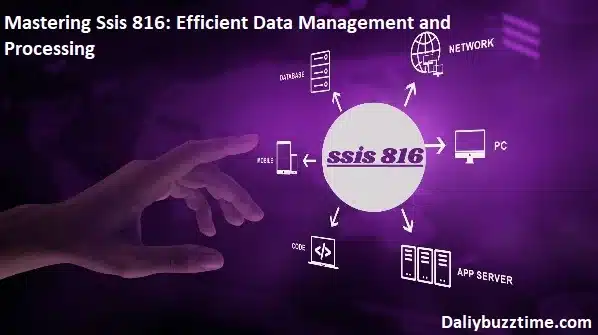
SQL Server Integration Services ssis 816 (SSIS) is a powerful data integration tool developed by Microsoft. It enables users to extract, transform, and load (ETL) data from various sources to destination systems. Whether you’re a beginner or an experienced developer, understanding ssis 816 is essential for efficient data management and processing.
Understanding the Basics of SSIS
ssis 816 is a component of the Microsoft SQL Server database software. It provides a platform for building high-performance data integration and workflow solutions. With SSIS, users can create packages to automate tasks such as importing data from flat files, Excel spreadsheets, or relational databases.
Components of SSIS
SSIS consists of various components, including control flow tasks, data flow tasks, event handlers, variables, and connection managers. These components work together to define the workflow of data integration processes.
Installation Process
To begin using SSIS, you need to install SQL Server Data Tools ssis 816 (SSDT) or SQL Server Management Studio (SSMS), depending on your version of SQL Server. Once installed, you can create SSIS projects and packages.
Setting up SSIS Projects
In SSDT or SSMS, you can create a new Integration Services project and define the project settings. This includes configuring connections to data sources and destinations, specifying project parameters, and setting deployment options.
Data Sources and Destinations
SSIS supports a wide range of data sources and destinations, including SQL Server databases, flat files, Excel spreadsheets, and web services. You can use connection managers to establish connections to these sources and destinations within your SSIS packages.
Control Flow Tasks
Control flow tasks define the workflow of ssis 816 packages. Common control flow tasks include Execute SQL Task, File System Task, and Send Mail Task. You can arrange these tasks to execute sequentially or conditionally based on predefined constraints.
Data Flow Tasks
Data flow tasks handle the movement and transformation of data within ssis 816 packages. They consist of data flow components such as source, transformation, and destination. With data flow tasks, you can extract data from source systems, perform transformations, and load data into destination systems.
Manual Execution
You can execute ssis 816 packages manually from SSDT or SSMS by running them within the development environment. This allows you to test the functionality of your packages and troubleshoot any issues before deploying them to production.
Scheduled Execution
In a production environment, you can schedule the execution of SSIS packages using SQL Server Agent jobs or third-party scheduling tools. This enables you to automate data integration processes and ensure that they run at specific intervals or times.
Debugging and Troubleshooting SSIS Packages
When working with ssis 816 packages, you may encounter various issues such as data errors, package failures, or performance bottlenecks. Understanding common issues and their solutions is essential for effective troubleshooting.
Debugging Techniques
SSIS provides built-in debugging features such as breakpoints, data viewers, and logging options. These tools help you identify and resolve issues within your packages by inspecting data flow, variable values, and execution paths.
Advanced SSIS Features
Variables and expressions allow you to dynamically configure SSIS packages based on runtime values. You can use variables to store temporary data, configure package properties, or control the execution flow using expressions and scripts.
Error Handling
Error handling in ssis 816 involves capturing and managing errors that occur during package execution. You can use built-in error-handling features such as event handlers, error outputs, and logging to handle errors gracefully and maintain data integrity.
Scripting Tasks
Scripting tasks enable advanced functionality within ssis 816 packages using custom code written in languages such as C#, VB.NET, or PowerShell. You can use scripting tasks to implement complex transformations, interact with external systems, or extend ssis 816 capabilities.
Performance Optimization
To maximize the performance of your ssis 816 packages, you should optimize various aspects such as data flow design, parallelism, and memory usage. Implementing best practices such as using efficient data types, minimizing data movement, and optimizing transformations can significantly improve package performance.
Maintenance and Version Control
Maintaining ssis 816 packages involves regular updates, bug fixes, and enhancements to accommodate changes in data sources or business requirements. It’s essential to implement version control systems and deployment strategies to manage package versions, track changes, and ensure consistency across environments.
Integration of SSIS with Other Technologies
SSIS integrates seamlessly with other SQL Server components such as SQL Server Database Engines, Analysis Services, and Reporting Services. You can leverage ssis 816 to automate data workflows, load data into data warehouses, or process analytical data for reporting and analysis.
SSIS and Azure
With the rise of cloud computing, Microsoft has introduced Azure Data Factory, a cloud-based data integration service that complements SSIS. You can use Azure Data Factory to orchestrate data pipelines, integrate with Azure services, and scale data integration workloads in the cloud.
ETL Processes
One of the primary applications of ssis 816 is in ETL (Extract, Transform, Load) processes. Organizations use ssis 816 to extract data from multiple sources, transform it into a consistent format, and load it into target systems such as data warehouses or operational databases.
ssis 816 is also widely used for data migration projects, where data needs to be transferred from legacy systems to new platforms or databases.